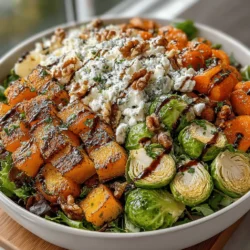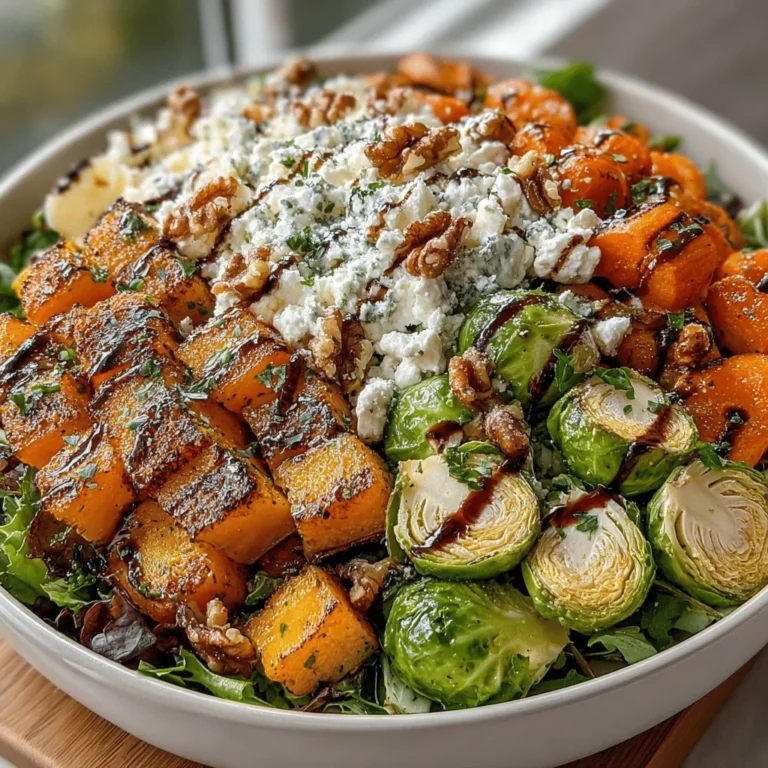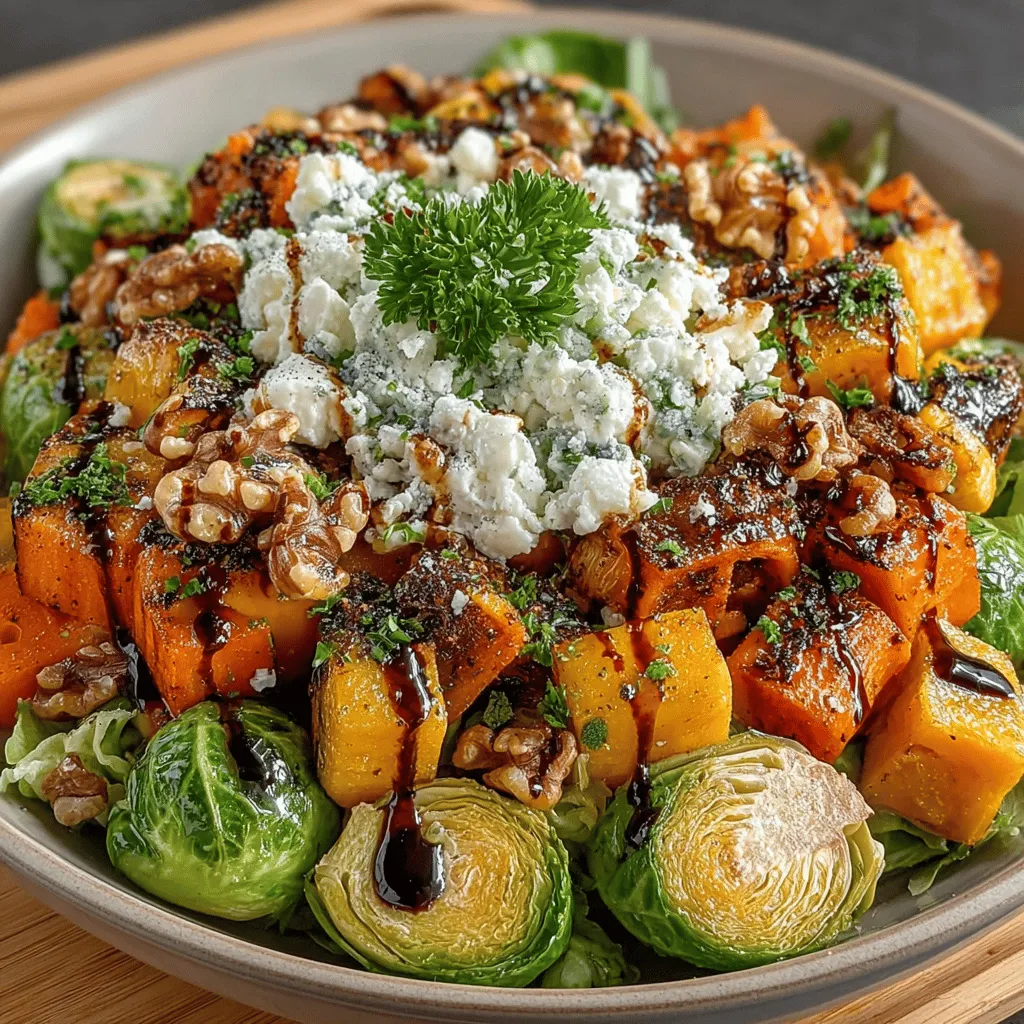Maple Roasted Autumn Vegetable Salad: A Seasonal Delight
As the leaves begin to change and the air turns crisp, the beauty of seasonal cooking comes into full bloom. Autumn is not just a transition from summer to winter; it’s a celebration of nature’s bounty. The cooler months bring forth a rich palette of flavors that invite us to gather around the table with family and friends. Among the many culinary delights that autumn offers, the Maple Roasted Autumn Vegetable Salad stands out as a quintessential dish that embodies the essence of the season.
This salad is not merely a combination of ingredients; it is a symphony of flavors that harmonize beautifully to create a wholesome and satisfying meal. Featuring the natural sweetness of maple syrup, the savory notes of fresh roasted vegetables, and the delightful crunch of walnuts, this salad is perfect for fall gatherings, potlucks, or simple weeknight dinners. It is a dish that not only nourishes the body but also warms the soul, making it an ideal choice for those seeking healthy eating options during the festive season.
The Appeal of Autumn Ingredients
One of the standout features of this Maple Roasted Autumn Vegetable Salad is its use of seasonal ingredients. As autumn unfolds, a variety of vegetables come into their prime, each contributing unique flavors and nutritional benefits. Key ingredients in this salad include butternut squash, Brussels sprouts, carrots, and red onion—each bringing its own distinctive taste and health properties to the dish.
Butternut Squash: This versatile winter squash is sweet, nutty, and creamy when roasted. It’s a fantastic source of vitamins A and C, as well as fiber, making it a great addition to any fall recipe. Its smooth texture adds depth to the salad, while its natural sweetness pairs beautifully with the maple syrup.
Brussels Sprouts: Often overlooked, Brussels sprouts are nutritional powerhouses. They are rich in antioxidants, vitamins K and C, and fiber. When roasted, these little cabbages develop a delightful caramelized flavor that enhances the overall profile of the salad. Choosing fresh Brussels sprouts is crucial; look for bright green, firm sprouts with tightly closed leaves.
Carrots: Carrots are another autumn staple that not only contribute a vibrant color to the dish but also offer a plethora of health benefits. They are an excellent source of beta-carotene, which the body converts into vitamin A. For added variety, consider using different types of carrots, such as rainbow or purple varieties, to elevate the visual appeal of your salad.
Red Onion: The subtle sweetness of roasted red onion ties the dish together beautifully. This ingredient provides a mild pungency that balances the sweetness of the maple syrup and the earthiness of the other vegetables. When selecting red onions, opt for firm bulbs with a glossy skin, avoiding any that are soft or have blemishes.
Using fresh, local produce during the autumn season not only enhances the flavor of your dishes but also supports local farmers and reduces your carbon footprint. Seasonal cooking is a celebration of the earth’s cycles, allowing us to appreciate the bounty that each season brings.
Creating the Perfect Maple Roasted Autumn Vegetable Salad
The Maple Roasted Autumn Vegetable Salad is designed to showcase the natural flavors of its components while creating a harmonious balance of taste and texture. The recipe is straightforward yet allows for creativity, making it suitable for both novice cooks and seasoned chefs.
In this salad, you’ll find a delightful blend of sweet, savory, and earthy notes. The sweetness from the maple syrup contrasts beautifully with the savory roasted vegetables, while the walnuts add a satisfying crunch that elevates the entire dish. The addition of aromatic herbs such as dried thyme and a sprinkle of cinnamon brings warmth and depth, making each bite a comforting experience.
Ingredients Breakdown
To create this flavorful Maple Roasted Autumn Vegetable Salad, you’ll need a selection of high-quality ingredients, each contributing to the dish’s overall success. Let’s break down the essential components:
– Butternut Squash: Known for its sweet and nutty flavor, butternut squash is typically roasted to bring out its natural sugars. When preparing, make sure to peel it, remove the seeds, and cut it into even cubes to ensure uniform cooking.
– Brussels Sprouts: For the freshest Brussels sprouts, look for ones that are firm and vibrant green. Cut them in half to allow for even roasting and to enhance their caramelization. Roasting at a high temperature will give them a crispy exterior while maintaining a tender interior.
– Carrots: Choose fresh carrots with vibrant color and a firm texture. You can slice them into rounds or sticks for a different presentation. If possible, consider using heirloom varieties for added flavor and visual appeal.
– Red Onion: Slice the red onion into wedges to allow for even roasting, which will mellow its strong flavor and enhance its sweetness. Alternatively, you can use shallots if you prefer a milder taste.
– Olive Oil: A high-quality extra virgin olive oil is essential for roasting. It not only helps to achieve that golden-brown color but also adds a rich flavor that complements the other ingredients.
– Pure Maple Syrup: Look for 100% pure maple syrup, as it contains no additives or artificial flavors. It adds a natural sweetness and depth to the salad, enhancing the roasted vegetables.
– Dried Thyme and Cinnamon: These spices add warmth and complexity to the salad. Thyme has earthy notes that elevate the dish, while cinnamon provides a hint of sweetness and nostalgia, reminiscent of autumn baking.
– Mixed Greens: A bed of mixed greens—such as arugula, spinach, or kale—serves as the perfect base for the roasted vegetables. They provide a fresh contrast and additional nutrients, making the salad well-rounded.
With these ingredients in hand, you’re well on your way to creating a Maple Roasted Autumn Vegetable Salad that not only celebrates the season but also tantalizes the taste buds. In the next part of the article, we will delve into the step-by-step process of preparing this delicious dish, ensuring that you can recreate this seasonal delight in your own kitchen.
Walnuts and Feta Cheese: Optional Toppings and Their Impact on Flavor and Texture
When it comes to enhancing the flavor and texture of your Maple Roasted Autumn Vegetable Salad, consider adding walnuts and feta cheese as optional toppings. Walnuts bring a delightful crunch and a rich, buttery flavor that perfectly complements the sweetness of the roasted vegetables. Their healthy fats also contribute to a satisfying mouthfeel, making each bite more enjoyable.
Feta cheese, on the other hand, adds a tangy, creamy element that balances the sweetness of the maple glaze. The saltiness of the feta contrasts beautifully with the natural sugars in the roasted vegetables, creating a harmonious blend of flavors. If you prefer a dairy-free option, feel free to substitute the feta with a vegan cheese alternative or simply omit it altogether. Both toppings can elevate the dish, making it not only more visually appealing but also more nutritionally diverse.
Balsamic Vinegar: Types and Flavor Profiles
Balsamic vinegar is a key ingredient in many salads, and its role in the Maple Roasted Autumn Vegetable Salad cannot be overstated. There are several types of balsamic vinegar available, each with its unique flavor profile:
1. Traditional Balsamic Vinegar: This is the highest quality balsamic, aged for at least 12 years. It has a rich, complex flavor with sweet and tangy notes, making it an excellent choice for drizzling over salads.
2. Commercial Balsamic Vinegar: This variety is more common and often less expensive. It typically has a more pronounced acidity and sweetness, which can work well in dressings but may not provide the depth of flavor that traditional balsamic does.
3. Balsamic Glaze: This is a thicker, syrupy form of balsamic vinegar that has been reduced to concentrate its flavor. It’s perfect for drizzling over the salad just before serving, adding a sweet touch that enhances the overall dish.
When selecting balsamic vinegar for your salad, consider your personal taste preferences and the flavor intensity you desire in your dish. A well-chosen balsamic can elevate your salad to new heights.
Step-by-Step Instructions for Preparation
Preheating the Oven: Importance of Temperature for Roasting
Begin by preheating your oven to 425°F (220°C). Preheating is crucial for achieving the perfect roast on your vegetables, allowing them to caramelize and develop rich flavors. A hot oven encourages the vegetables to cook evenly and enhances their natural sweetness while ensuring a crispy texture.
Preparing the Vegetables: Tips for Cutting and Mixing
Next, prepare the vegetables. For this salad, you’ll typically use a combination of root vegetables like sweet potatoes, carrots, and beets, along with seasonal favorites such as Brussels sprouts and butternut squash.
1. Cutting: Aim for uniform pieces to ensure even cooking. For root vegetables, cut them into 1-inch cubes, while Brussels sprouts can be halved. This uniformity allows all the vegetables to roast at the same rate, preventing some from being overcooked while others are underdone.
2. Mixing: In a large mixing bowl, combine the chopped vegetables. Drizzle with olive oil and sprinkle with salt and pepper. Toss everything well to ensure an even coating. This step is essential as it will help the seasoning penetrate the vegetables, resulting in a more flavorful salad.
Seasoning and Tossing: Importance of Even Coating for Flavor
Once your vegetables are prepared and mixed, it’s time to season them. Add a generous drizzle of maple syrup and a splash of balsamic vinegar to the bowl. The maple syrup will add a touch of sweetness that enhances the autumn flavors, while the balsamic vinegar provides a tangy contrast.
Toss the vegetables again, ensuring they are evenly coated with the maple and balsamic mixture. This step is crucial because a well-seasoned vegetable medley will yield the best-tasting salad.
Roasting Process: Timing and Signs of Doneness
Transfer the seasoned vegetables to a large baking sheet, spreading them out in a single layer. This allows for optimal roasting, as overcrowding can lead to steaming instead of roasting.
Roast the vegetables in the preheated oven for 25 to 30 minutes. Halfway through the cooking time, stir the vegetables to ensure even browning. You’ll know your vegetables are done when they are tender and caramelized at the edges. The sweet aroma wafting through your kitchen will be an added bonus!
Assembling the Salad: Layering for Presentation and Taste
Once the vegetables are roasted to perfection, it’s time to assemble your salad. Start by placing a bed of mixed greens, such as arugula or spinach, in a large serving bowl or platter. The greens provide a fresh contrast to the warm roasted vegetables.
Layer the roasted vegetables on top of the greens, creating an inviting presentation. For added color, you might want to include sliced radishes or cherry tomatoes. The layers not only make the salad visually appealing but also add different textures and flavors in every bite.
Adding Toppings: Timing for Optimal Crunch and Flavor
Before serving, consider adding your optional toppings. If you choose to include walnuts, chop them coarsely and toast them lightly in a dry skillet for extra crunch. Add them on top of the salad just before serving to retain their crispness.
For those who prefer feta cheese, crumbling it over the top of the salad will provide a creamy contrast to the roasted vegetables. Again, add these toppings just before serving to maintain their texture and flavor.
Dressing the Salad: Balancing Flavors with Vinegar
Finally, dress the salad with a little more balsamic vinegar, drizzling it over the assembled ingredients. This is where you can adjust the balance of flavors to your liking. If you prefer a tangier profile, add more vinegar; for a sweeter note, drizzle a little extra maple syrup. Toss gently to combine, ensuring all components are coated without bruising the greens.
Nutritional Information
The Maple Roasted Autumn Vegetable Salad is not only delicious but also packed with nutritional benefits. This salad is rich in vitamins and minerals from the variety of vegetables, providing a colorful array of nutrients.
– Calories: Approximately 250 calories per serving (without toppings).
– Protein: 5 grams (can be increased with the addition of chickpeas or grilled chicken).
– Fats: 12 grams (mostly from healthy fats in olive oil and walnuts).
– Vitamins: High in Vitamins A, C, and K, along with essential minerals like potassium and magnesium.
This salad is versatile and can fit into various dietary lifestyles. For those following a vegan or vegetarian diet, it’s a wholesome option packed with plant-based goodness. If you need a gluten-free meal, rest assured that this salad meets that requirement as well.
Serving Suggestions and Pairings
The Maple Roasted Autumn Vegetable Salad is perfect for a variety of occasions. It shines at family gatherings, potlucks, or even as a meal prep option for busy weeks. It can be served warm or at room temperature, making it adaptable to any setting.
Recommended Pairings with Proteins
To create a well-rounded meal, consider pairing this salad with a protein of your choice. Grilled chicken or turkey works wonderfully, adding lean protein to the dish. If you prefer a vegetarian option, roasted chickpeas or quinoa can enhance the nutritional profile while keeping it hearty.
Ideas for Complementary Side Dishes or Beverages
For side dishes, consider serving crusty whole-grain bread or a light soup, such as butternut squash or lentil soup, to complement the flavors of your salad. As for beverages, a crisp white wine, such as Sauvignon Blanc, pairs beautifully, or opt for sparkling water with a splash of citrus for a refreshing non-alcoholic option.
Conclusion
In summary, the Maple Roasted Autumn Vegetable Salad is a versatile and nutritious dish that celebrates the flavors of the season. With its delightful combination of roasted vegetables, fresh greens, and optional toppings, this salad is sure to impress at any gathering.
Embracing seasonal cooking not only enhances the flavors of your meals but also supports local farmers and promotes sustainability. By incorporating wholesome ingredients into your everyday meals, you can enjoy the numerous health benefits while discovering new flavor profiles.
So, gather your ingredients, roast your vegetables, and indulge in the rich, comforting tastes of autumn with this vibrant salad. It’s an invitation to enjoy the bounty of the season while nourishing your body with every delicious bite.



